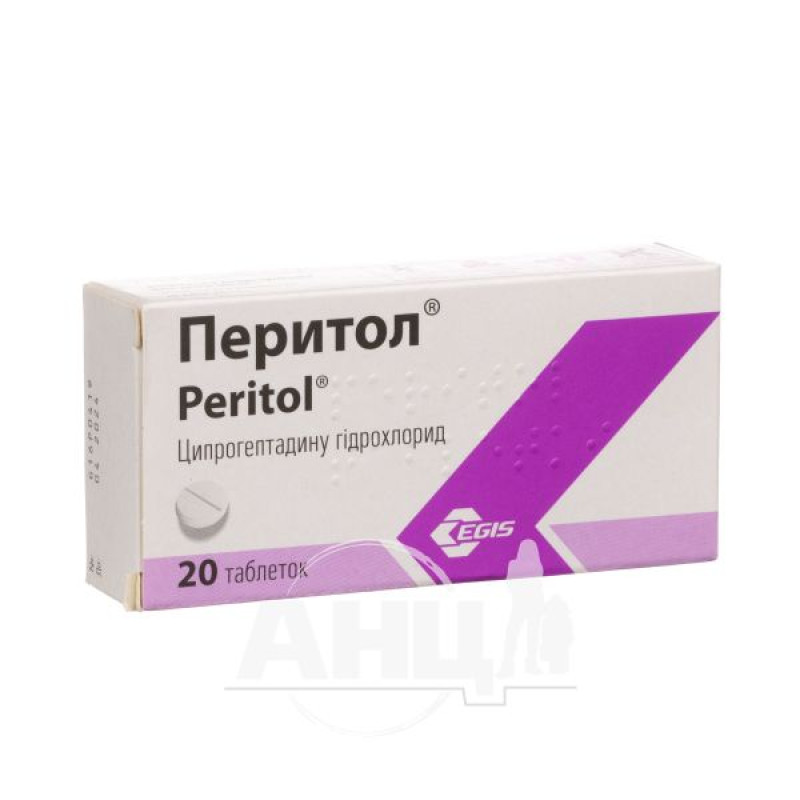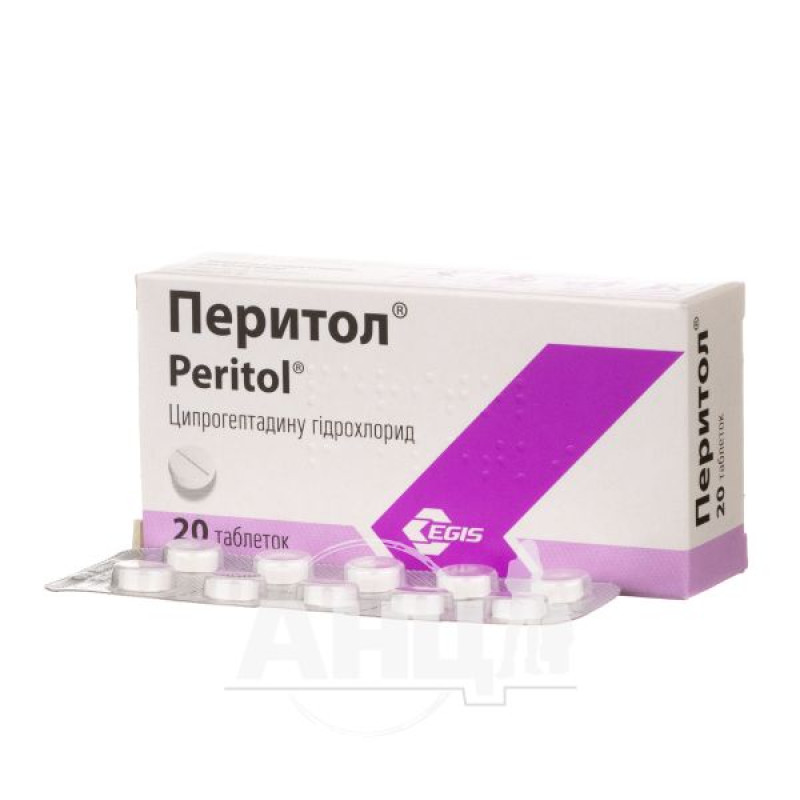Peritol tablets 4 mg blister No. 20

Pharmacological properties
Antihistamine drug (H1-receptor blocker), which has an antiserotonin effect. Prevents the development and alleviates the course of allergic reactions. In addition to antiallergic, it has antipruritic, antiexudative, anticholinergic and sedative effects, stimulates appetite.
When taken orally, it is quickly and well absorbed in the gastrointestinal tract. The maximum concentration in the blood is achieved within the first 2 hours; the therapeutic level of concentration is maintained for 4-6 hours. Penetration of the drug through the placental barrier and into breast milk has not been proven. It is intensively metabolized in the liver, from 2 to 20% is excreted through the stomach, 34% - in unchanged form. At least 40% of the administered dose of the drug is excreted in the urine. The half-life is 16 hours.
Indication
Acute and chronic urticaria, serum sickness, hay fever, vasomotor and allergic rhinitis; allergic reactions that occur when taking medications, rash, eczematous, contact dermatitis, neurodermatitis, angioedema, insect bites, carcinoid syndrome, headache of vascular origin (migraine, "histamine" headache). The drug can also be used for anorexia of various origins (anorexia nervosa, idiopathic anorexia), as well as for cachexia (due to an infectious disease, with exhaustion, hyperthyroidism).
Application
Tablets: usually the initial daily dose is 12 mg (1 tablet 3 times a day). This dose can be increased to a maximum of 32 mg/day (until symptoms disappear or as directed by a doctor).
Chronic urticaria: 6 mg/day (1/2 tablet 3 times a day) until symptoms of the disease disappear.
Acute migraine attack: 1 tablet. If the pain continues to bother, the drug can be taken again in the same dose after 30 minutes, but not more than 8 mg (2 tablets) within 4-6 hours.
For maintenance therapy, in most cases, it is sufficient to take 4 mg (1 tablet) 3 times a day.
Anorexia: in case of anorexia, 1 tablet is used 3 times a day. For children aged 3-6 years - 6 mg/day (1/2 tablet 3 times a day). The maximum dose can be increased to 8 mg/day (no more than 2 tablets).
For children aged 7-14 years, the dose is 12 mg/day (1 tablet 3 times a day).
Syrup: adults: usually the initial dose is 12 mg (10 ml of syrup 3 times a day).
This dose can be increased to a maximum of 32 mg/day (4 times 20 ml of syrup).
For chronic urticaria in adults - 6 mg/day (5 ml of syrup 3 times a day), for migraine - 4 mg/day (10 ml of syrup at a time). If the pain continues to bother, the drug can be taken in the same dose after 30 minutes. Do not use a dose higher than 8 mg (10 ml 2 times a day) for 4-6 hours.
For maintenance therapy, 12 ml (3 times 10 ml/day) is usually sufficient. The treatment period depends on the effectiveness of the therapy and the patient's condition and is determined by the doctor.
Children aged 2-6 years are prescribed a dose of 0.25 mg/kg of body weight; at the age of 7-14 years the daily dose is 8-12 mg (10 ml of syrup 2-3 times a day).
1 teaspoon contains 5 ml of syrup. 1 dessert spoon contains 10 ml of syrup.
In patients with impaired renal or hepatic function, a dose reduction may be necessary.
Contraindication
Peritol tablets and syrup are used for:
• hypersensitivity to the components of the drug;
• glaucoma;
• peripheral edema;
• benign prostatic hyperplasia;
• urination disorders;
• during pregnancy and breastfeeding;
• children under 2 years of age.
Side effects
CNS: most often - drowsiness, usually disappears after 3-4 days, sometimes as a result of this it is necessary to cancel the drug. Among other side effects - sedative effect, dizziness, tinnitus, confusion, impaired coordination of movements, ataxia, accommodation disorders (mydriasis), double vision, visual hallucinations, anxiety, tremor, increased irritability, insomnia, paresthesia, neuritis, headache, weakness.
Allergic reactions: erythema, purpura, urticaria, edema. In rare cases - Quincke's edema and anaphylactic shock.
Skin: erythema, skin rash, photosensitivity.
Hematopoietic system: hemolytic anemia, leukopenia, agranulocytosis, thrombocytopenia.
Cardiovascular system: hypotension, tachycardia, extrasystole.
Respiratory system: thickening of bronchial secretions, dyspnea, rhinitis.
Gastrointestinal tract: dry mouth, nausea, vomiting, epigastric discomfort, diarrhea or constipation, cholestasis, hepatitis, jaundice.
Human anatomical models: frequent urination, difficulty emptying the bladder, urinary retention.
Other side effects: while taking Peritol, patients often gain weight.
Special instructions
Due to the sedative effect of the drug at the beginning of the course of treatment, it is recommended to take the first dose in the evening after the last meal.
Caution should be exercised when using Peritol in debilitated or elderly patients, as they may be more likely to develop side effects (dizziness, drowsiness, hypotension).
In the initial period of therapy, patients may complain of dizziness, drowsiness. Therefore, at the beginning of the course of treatment with Peritol, it is necessary to refrain from driving vehicles and working with mechanisms, as well as performing work that requires increased attention. In the future, the degree of this restriction is determined individually.
Due to the presence of an anticholinergic effect, it is recommended to exercise caution when prescribing Peritol in the following conditions:
• BA;
• high intraocular pressure;
• hyperthyroidism;
• cardiovascular diseases;
• AG.
Alcohol may enhance the inhibitory effect of antihistamines on the central nervous system (sedative effect). Therefore, it is forbidden to drink alcoholic beverages during treatment with Peritol.
Prolonged use of antihistamines may in some cases cause hematopoiesis disorders (leukopenia, agranulocytosis, thrombocytopenia, hemolytic anemia). Therefore, patients with complaints of unexplained fever, sore throat, lesions of the oral mucosa, jaundice, ecchymosis, continuous bleeding should be carefully examined with a hemogram. If severe disorders are detected, the need for drug withdrawal should be considered.
Peritol syrup contains sucrose. 1 teaspoon (5 ml) contains 2 g, 1 dessert spoon (10 mg) contains 4 g of sucrose. Therefore, the syrup is contraindicated for children with fructose intolerance or glucose/galactose malabsorption, as well as with sucrose/maltose insufficiency.
Peritol contains 5% alcohol. 1 teaspoon of syrup (5 ml) contains 0.25 g, and 1 dessert spoon (10 mg) contains 0.5 g of alcohol. Peritol syrup should be used with great caution in liver disease, alcoholism, epilepsy, brain injury or other CNS diseases. Long-term (more than 1 week) use of the syrup in children should be carried out only after careful consideration of the benefit/risk ratio.
The syrup should be used within 4 weeks after first opening the bottle.
Interactions
MAO inhibitors enhance and prolong the anticholinergic effect of the drug.
Caution is required when using Peritol simultaneously with other substances that depress the activity of the central nervous system (hypnotics, sedatives, anxiolytics, alcohol), as their sedative effect may be enhanced.
Overdose
Symptoms: in children - excessive excitement, restlessness, hallucinations, convulsions. in adults - depression, coma, sometimes - psychomotor agitation, convulsions.
Treatment: gastric lavage, use of activated charcoal; in case of development of pronounced atropine-like effects - parenteral administration of physostigmine salicylate solution; according to indications - vasoconstrictor and anticonvulsant drugs. Artificial ventilation of the lungs and other resuscitation measures.
Storage conditions
At a temperature of 15-25 °C. after opening the bottle of syrup, use it within 4 weeks.
There are no reviews for this product.
There are no reviews for this product, be the first to leave your review.
No questions about this product, be the first and ask your question.







